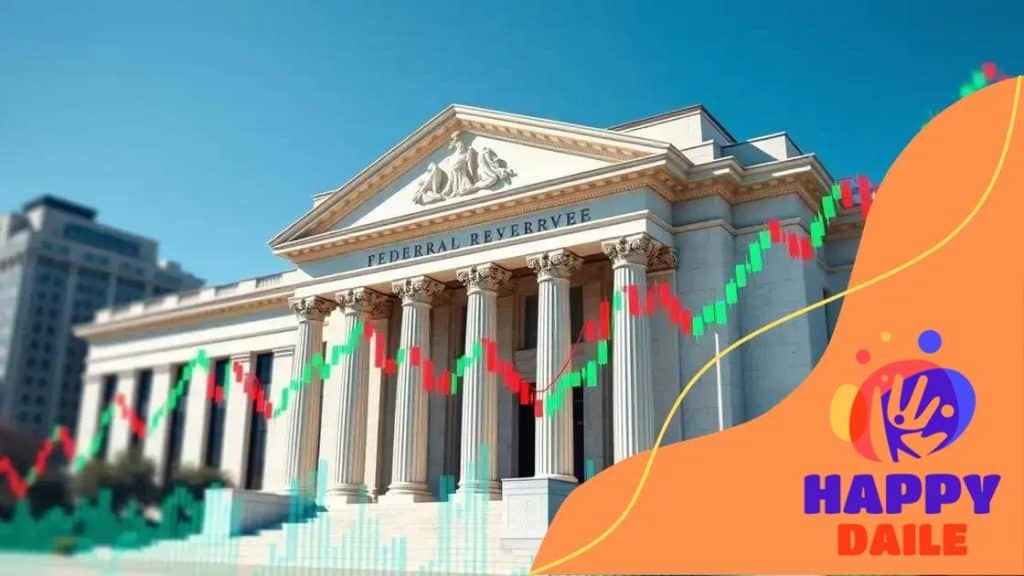Fed explores rate hikes: Wallet, loans, and investments

Anúncios
Fed explores rate hikes as inflation concerns linger, leaving many to question how this affects their wallets and investments. These changes aren’t just headlines, they shape your everyday financial decisions.
From mortgage rates to credit card interest and stock market shifts, the ripple effects are real. Understanding what’s behind the Fed’s moves can help you plan smarter and act faster.
Anúncios
Understanding recent Federal Reserve decisions
Fed explores rate hikes in response to shifting economic signals, making it vital for consumers to understand how the Federal Reserve shapes the financial landscape.
The Fed adjusts its key interest rate to balance growth and inflation. These changes influence borrowing costs, credit availability, and market behavior across the board.
Whether you’re saving, investing, or borrowing, the Fed’s decisions guide the economy’s direction. Knowing why the Fed acts helps you make smarter money moves and long-term plans.
Recent changes in interest rates
Fed explores rate hikes as inflationary pressures remain persistent, prompting careful recalibration of interest rates in recent months.
Anúncios
As inflation crept above target levels, the Fed responded with incremental rate increases to temper demand and encourage saving over spending.
These changes don’t just affect Wall Street, they shape loan rates, credit cards, and how much we pay for everyday necessities. Every hike sends ripples through your wallet.
How these decisions impact you
When the Fed explores rate hikes, your financial life shifts, often in ways you don’t immediately notice, but deeply feel over time.
Higher rates can mean costlier mortgages, personal loans, and auto financing. That dream home or new car might now carry a steeper price tag over time.
Investors may also face choppy waters. Stocks could drop as borrowing tightens, and savings accounts may yield more. Understanding these moves helps you stay one step ahead.
How rate hikes affect inflation
As the Fed explores rate hikes, one core goal stands out: curbing inflation by cooling an overheated economy without causing a recession.
When borrowing becomes more expensive, consumer spending tends to decline. Lower demand often forces businesses to stabilize or reduce prices to attract customers.
By pulling back on excess spending, rate hikes are designed to restore balance in the market and tame price spikes across everyday goods and services.
The mechanics of rate hikes
Each time the Fed explores rate hikes, it pulls a lever that shifts the mechanics of borrowing, investing, and saving.
Higher rates ripple through the economy by making credit cards, business loans, and mortgages more expensive. As access to cheap money tightens, economic momentum slows.
This deliberate deceleration aims to prevent inflation from spiraling. With tighter conditions, people and businesses rethink how and where they spend, slowing inflationary trends.
The impact on consumer prices
When the Fed explores rate hikes, the ultimate aim is to influence the prices consumers face daily, from groceries to gas to rent.
You might not feel it immediately, but rate hikes gradually reduce the pace of price increases. Retailers often adjust pricing based on changes in demand and credit costs.
But inflation isn’t just about now, it’s about expectations. The Fed tries to manage future pricing behavior by sending signals through current interest rate policy.
The impact on consumer loans and mortgages
Understanding the impact on consumer loans and mortgages due to rate hikes is essential for anyone seeking financing. When the Federal Reserve raises interest rates, it creates a ripple effect throughout the lending landscape.
Higher interest rates mean that loans become more expensive. This is particularly true for mortgages, auto loans, and personal loans. For potential homebuyers, a higher mortgage rate can significantly increase monthly payments, making homes less affordable.
The effect on mortgage rates
As the Fed explores rate hikes, the real estate market reacts, often swiftly. Lenders adjust mortgage offers, and buyers rethink affordability.
Rising rates shrink buying power. A fixed-rate mortgage might suddenly seem more attractive than a variable option, which could escalate quickly.
For current homeowners, refinancing becomes less appealing. For new buyers, affordability shifts, impacting the pace and competitiveness of home sales nationwide.
Consumer behavior and borrowing trends
Each time the Fed explores rate hikes, it reshapes consumer sentiment. People borrow less, spend less, and shift focus toward saving or debt payoff.
This pullback from spending can reduce economic growth in the short term, but it’s often necessary to rein in runaway prices.
Lenders respond too, tightening approvals or raising credit standards. Staying informed helps you adapt quickly, especially when big purchases are on the horizon.

Investing strategies in a rising interest rate environment
When the Fed explores rate hikes, the rules of investing evolve. Strategies that once thrived in low-rate environments may now pose new risks.
Rising rates often weaken bond values and create turbulence in growth stocks. Diversifying into multiple asset classes can offer resilience and opportunity.
Understanding which investments benefit in high-rate cycles helps you make better decisions and avoid pitfalls tied to outdated strategies.
Focus on short-term investments
If the Fed explores rate hikes, short-term investments can offer more stability and liquidity than long-duration assets.
Products like short-term bonds or high-yield savings accounts are less volatile and can adapt faster to rising yields. These instruments offer income with minimal exposure.
This flexibility becomes essential when conditions shift rapidly. Keeping your money accessible while earning returns is a smart play in a changing rate landscape.
Evaluate sectors likely to thrive
Each time the Fed explores rate hikes, certain industries shine. Financials, energy, and value stocks often fare better when rates climb.
Banks, for instance, benefit from rising loan margins. Other resilient sectors, like utilities or dividend-rich companies, can help weather volatility.
By identifying sectors that outperform in high-rate periods, you position your portfolio for stronger gains and reduced downside risk.
Expert insights on future rate predictions
When the Fed explores rate hikes, analysts, economists, and financial advisors dive deep into data to anticipate the Fed’s next moves.
These predictions are based on employment numbers, inflation trends, and economic growth. A strong labor market or persistent inflation might signal further hikes ahead.
Tracking expert commentary can give you a clearer picture of what’s coming, and how to prepare for both the expected and the unexpected.
Key economic indicators to watch
Investors should pay attention to several key economic indicators when considering future rate changes. These include:
- Inflation rates: A rise in prices can push the Fed to increase rates.
- Employment data: Strong job growth can lead to higher demand, influencing the Fed’s decisions.
- Consumer spending: Increased spending signifies a healthy economy, which may prompt interest rate hikes.
- Global economic trends: International events can exert pressure on domestic monetary policies.
Understanding these factors can provide insights into potential rate changes and help you strategize accordingly.
Market reactions and predictions
Whenever the Fed explores rate hikes, markets respond swiftly, stocks fluctuate, bond yields climb, and investor sentiment shifts.
Increased rates can trigger selloffs in interest-sensitive sectors, while savers might enjoy higher returns. Forecasts often ripple through global markets as well.
By monitoring these responses, you can adapt your financial game plan. Stay nimble, informed, and prepared for the next adjustment.
FAQ – Frequently Asked Questions about Interest Rate Changes and Financial Strategies
How do interest rate hikes affect my mortgage payments?
When interest rates rise, mortgage payments can increase as lenders adjust rates, making loans more expensive.
What should I consider when adjusting my investment strategy?
Focus on diversifying your portfolio and consider short-term investments that are less sensitive to interest rate changes.
Are there indicators I should watch for interest rate predictions?
Yes, key indicators include inflation rates, employment data, and overall consumer spending trends.
How can I seek expert advice on my financial decisions?
Consulting with financial advisors can provide tailored strategies based on your situation and current market conditions.





